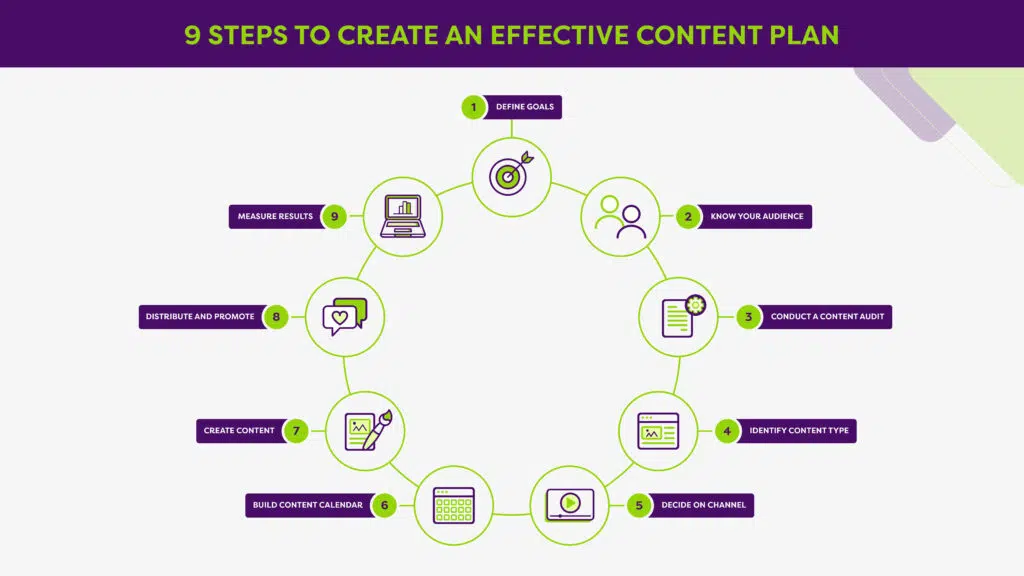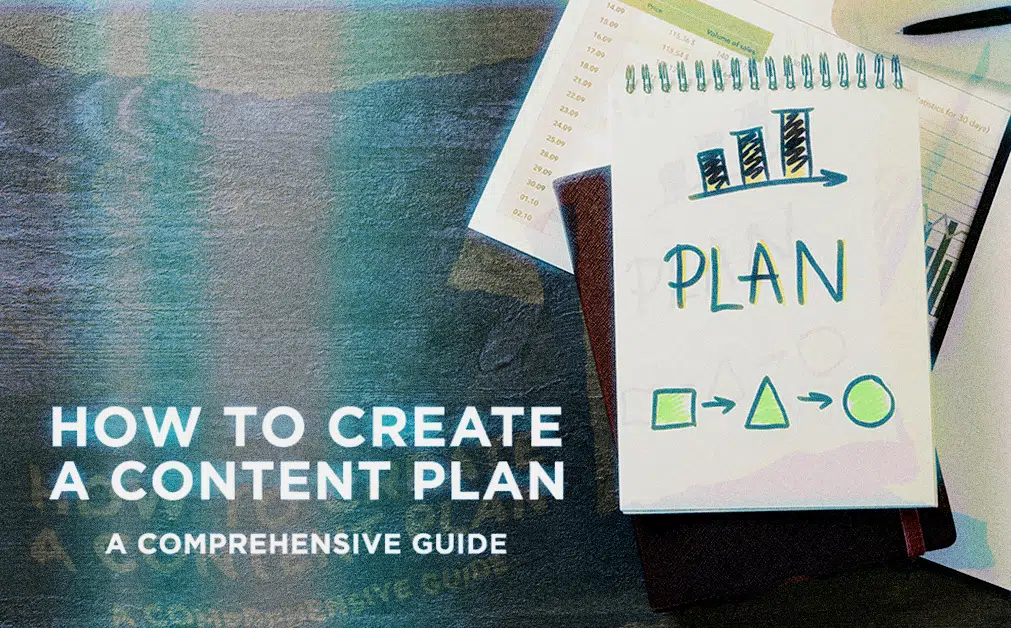Wondering how to create a content plan that truly connects with your audience and boosts your brand? Many marketers find themselves grappling with this very challenge.
This is especially true when it involves blog posts and social media content. This comprehensive guide helps simplify the process.
It acts as your roadmap. From setting clear objectives to measuring success, we provide everything needed for impactful content. So, let’s dive into exactly how to create a content plan.
Get your FREE Marketing Check now!
Table of Contents
- Understanding the Basics of Content Planning
- Steps to Create an Effective Content Plan
- Define Your Content Goals
- Understand Your Target Audience
- Conduct a Content Audit
- Choose Your Content Types and Channels
- Develop a Content Calendar
- Create Compelling Content
- Distribute and Promote Your Content
- Measure and Analyse Your Results
- Conclusion
- FAQs about How To Create a Content Plan
-
- How do I create content plans?
- What is included in a content plan?
- What are the 5 Cs of content creation?
- What are the 7 steps in creating a content strategy?
-
Understanding the Basics of Content Planning
Before we proceed, it’s important to grasp what a content plan entails. It’s a strategic framework outlining your content marketing strategy, target audiences, and content types.
The plan guides your content marketing efforts, and this marketing strategy ensures each piece contributes to your business objectives.
A well-defined content plan assists you in several key ways:
- Staying organised and maintaining consistency in content creation
- Aligning your media content with overarching business goals
- Making sure you’re creating content that resonates with your target audience
- Maximising efficiency in your content marketing, and keeping messaging consistent

Steps to Create an Effective Content Plan
1. Define Your Content Goals
The first step is defining your marketing goals. What do you hope to achieve with your social media content as well as any other content?
Are you aiming for enhanced brand awareness, lead generation, or thought leadership? Outline goals that are SMART: Specific, Measurable, Achievable, Relevant, and Time-bound.
For example, instead of a general goal like “increase traffic,” aim to “increase organic traffic by 25% in six months with blog posts and infographics.”
2. Understand Your Target Audience
Creating content without understanding your audience is ineffective. Spend time developing detailed buyer persona profiles representing ideal customers.
Consider these aspects in your profiles:
- Demographics such as age, location, and job title
- Interests, pain points, and challenges they face
- Preferred content types and platforms
- Buying behaviours and decision-making processes
Using tools to help you follow industry trends, also aids your content planning and ensures content remains relevant and engaging.
3. Conduct a Content Audit
Before producing pieces of new content, assess your existing inventory. A content audit will help identify your best content.
It also reveals gaps and outdated material. Doing a content audit allows you to know what to create and update.
This provides insights into what resonates. You also gain an understanding of where to adjust your strategy for the best results.
4. Choose Your Content Types and Channels
Based on marketing goals and what your target audiences prefer, choose your content types and channels. It can include any of the following.
- Blog posts
- Social media content
- Videos
- Podcasts
- Ebooks or whitepapers
- Infographics
It’s wiser to focus on just a few channels rather than many. Concentrate on where your audience is most active and most engaged, and also, where you will get a good return.
5. Develop a Content Calendar
A content calendar, also known as an editorial calendar, keeps your plan organised. It helps schedule content in advance, providing a steady stream of value for your audience.
Your calendar should include:
- Content ideas and titles
- Publication dates for publishing content
- Content types
- Distribution channels
- Team members responsible for each piece
There are lots of good tools around for calendar management. With these, you will always have effective content.
6. Create Compelling Content
Now, start creating content. Your goal with the content is to have an effective content plan. Concentrate on quality and addressing your audience’s needs.
Here’s how to make engaging content:
- Use captivating headlines.
- Add visuals to break up text. These will help illustrate the main points.
- Write in a relatable, conversational style.
- Support claims with data. Also, add in expert opinions.
- Optimise for search engines. With a little bit of search engine optimisation, your content will get more visibility.
Read more about how to create compelling content.
7. Distribute and Promote Your Content
Creating top-notch content is just the start of getting your content read. You also need distribution efforts and a solid promotion plan.
Consider these methods to aid in your marketing:
- Sharing across social media platforms.
- Email marketing to subscribers.
- Partnering with industry influencers.
- Paid advertising. Use social ads or Google Ads to extend your content reach.
Different content may need different promotion strategies. A social media strategy might use organic sharing and partnerships.
8. Measure and Analyse Your Results
The last step is monitoring your content’s performance. You should look to analyse regularly, much like when completing a content audit.
This shows what works and where to improve. Essential metrics include:
| Metric | Description |
| Website Traffic | Total visits and page views. |
| Engagement | Likes, shares, and comments. |
| Conversions | Actions taken, like sign-ups. |
| Time on Page | How long visitors stay. |
| SEO Rankings | Where your content appears in search results. |
Google Analytics and social insights provide this data. Assess metrics and tweak your marketing plan to boost results.
Conclusion
Mastering how to create a content plan is vital for a winning content marketing strategy. Consistent, valuable content builds a strong online presence, connects with audiences, and meets business objectives. Regularly revisit and adapt your plan for business and audience changes, in this fast-paced digital age.
You have the start for enhancing brand awareness with a well-defined content plan that guides your efforts. Also, be sure to use different content types to connect to your audience on different levels.
By doing so, you will ensure the journey of keeping messaging on point for all of your content types. Now get started in planning to achieve a rewarding destination.
Connect with me on LinkedIn.
FAQs about How To Create a Content Plan
How do I create content plans?
Begin by setting goals, researching your audience, and auditing current content. Next, select formats and channels. It is also a great plan to look into creating an editorial calendar.
Then, plan content, create it, promote it, and analyse results. Don’t forget about adding your content pillar topics to your plan.
Using all of these together is part of any sound content plan.
What is included in a content plan?
A sound content plan includes goals, audience insights, formats, and channels. A calendar and metrics for success should also be in there.
You may also want to look at adding personas, keywords, and themes. Using an editorial calendar, you have what it takes for your plan to help in your journey of driving traffic.
What are the 5 Cs of content creation?
They are: Company (your brand), Customers (your audience), Competitors (your rivals), Content (your material), and Channels (your platforms). With those, you are off to a great start for creating engaging social media campaigns.
Remember, consistency in content creation is crucial for keeping your audience engaged and coming back for more.
What are the 7 steps in creating a content strategy?
The steps in creating your content strategy are: 1) Set goals, 2) Research your audience, 3) Audit content, 4) Pick formats and channels, 5) Create a calendar, 6) Produce and distribute, and 7)
Analyse results. In the fast-paced digital world, staying agile and adaptable is important.
Always be prepared to adjust your strategy based on performance data and evolving trends. This helps create your content’s effectiveness.
